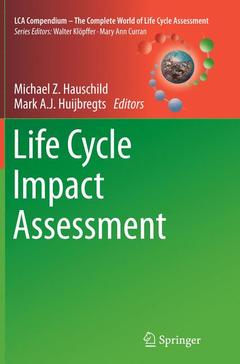Description
Life Cycle Impact Assessment, Softcover reprint of the original 1st ed. 2015
LCA Compendium – The Complete World of Life Cycle Assessment Series
Language: English
Subject for Life Cycle Impact Assessment:
Publication date: 10-2016
Support: Print on demand
Publication date: 04-2015
339 p. · 15.5x23.5 cm · Hardback
Description
/li>Contents
/li>Comment
/li>
This book offers a detailed presentation of the principles and practice of life cycle impact assessment. As a volume of the LCA compendium, the book is structured according to the LCIA framework developed by the International Organisation for Standardisation (ISO)passing through the phases of definition or selection of impact categories, category indicators and characterisation models (Classification): calculation of category indicator results (Characterisation); calculating the magnitude of category indicator results relative to reference information (Normalisation); and converting indicator results of different impact categories by using numerical factors based on value-choices (Weighting).
Chapter one offers a historical overview of the development of life cycle impact assessment and presents the boundary conditions and the general principles and constraints of characterisation modelling in LCA. The second chapter outlines the considerations underlying the selection of impact categories and the classification or assignment of inventory flows into these categories. Chapters three through thirteen exploreall the impact categories that are commonly included in LCIA, discussing the characteristics of each followed by a review of midpoint and endpoint characterisation methods, metrics, uncertainties and new developments, and a discussion of research needs. Chapter-length treatment is accorded to Climate Change; Stratospheric Ozone Depletion; Human Toxicity; Particulate Matter Formation; Photochemical Ozone Formation; Ecotoxicity; Acidification; Eutrophication; Land Use; Water Use; and Abiotic Resource Use. The final two chapters map out the optional LCIA steps of Normalisation and Weighting.
Chapter 1 Introducing Life Cycle Impact Assessment; Michael Z. Hauschild and Mark A. J. Huijbregts.-Chapter 2 Selection of Impact Categories and Classification of LCI Results to Impact Categories; Jeroen Guinée.- Chapter 3 Climate Change; Annie Levasseur.- Chapter 4 Stratospheric Ozone Depletion; Joe Lane.- Chapter 5 Human Toxicity; Olivier Jolliet and Peter Fantke.- Chapter 6 Particulate Matter Formation; Sebastien Humbert, Peter Fantke and Olivier Jolliet.- Chapter 7 Photochemical Ozone Formation; Philipp Preiss.- Chapter 8 Ecotoxicity; Ralph K. Rosenbaum.- Chapter 9 Acidification; Rosalie van Zelm, Pierre-Olivier Roy, Michael Z. Hauschild and Mark A.J. Huijbregts.- Chapter 10 Eutrophication; Andrew D. Henderson.- Chapter 11 Land Use; Llorenç Milài Canals and Laura de Baan.- Chapter 12 Water Use; Stephan Pfister.- Chapter 13 Abiotic Resource Use; Pilar Swart, Rodrigo A. F. Alvarenga and Jo Dewulf.- Chapter 14 Normalisation; Alexis Laurent and Michael Z. Hauschild.- Chapter 15 Weighting; Norihiro Itsubo.




